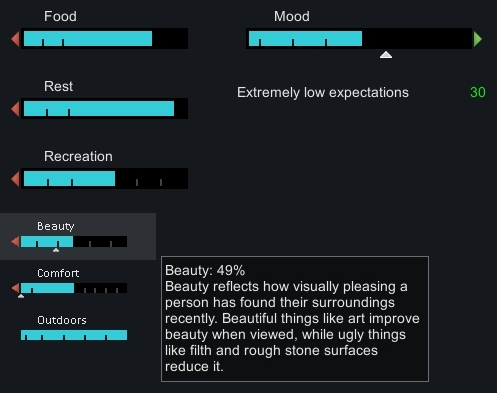Difference between revisions of "Needs"
| Line 26: | Line 26: | ||
[[File:Colonist needs beauty.png|frame|right|Example view of a colonist's needs window with the beauty level highlighted.]] | [[File:Colonist needs beauty.png|frame|right|Example view of a colonist's needs window with the beauty level highlighted.]] | ||
| − | This window is shown if you select a colonists '' | + | This window is shown if you select a colonists ''needs'' tab. It can also be displayed for prisoners, guests and tame animals, but will display fewer statistics in some of these cases (eg. animals do not have ''beauty'' and ''comfort'' needs, and no ''thoughts'' at all). |
The colonist in the displayed example has no positive or negative ''mood thoughts'' yet, besides a default thought reflecting his current expectations: in this case, particularly low expectations trigger a very positive mood thought, because the pawn evaluates his current situation as relatively positive, given how things are. | The colonist in the displayed example has no positive or negative ''mood thoughts'' yet, besides a default thought reflecting his current expectations: in this case, particularly low expectations trigger a very positive mood thought, because the pawn evaluates his current situation as relatively positive, given how things are. | ||
Revision as of 15:33, 6 September 2019
|
Needs
Colonists, and all human characters, have basic needs that, if not met or if met beyond expectations, may trigger Thoughts to appear below the Mood meter. The current Mood is a net result of these thoughts.
The basic needs, shown in the Needs tab, are:
- Food - the need for food.
- Rest - the need for sleep.
- Recreation - the need for enjoyable activities.
- Beauty - the need for a desirable place to live. Most colonists don't like environments covered in dirt, blood, or debris, and prefer to be in lavish rooms furnished with beautiful statues, large wooden royal beds, and plush carpeted flooring.
- Comfort - the need for comfortable places to sleep, eat and relax.
- Outdoors - the need to be outside
Besides basic needs, any drug addictions a pawn has are also listed as a need.
The Needs window of a pawn
This window is shown if you select a colonists needs tab. It can also be displayed for prisoners, guests and tame animals, but will display fewer statistics in some of these cases (eg. animals do not have beauty and comfort needs, and no thoughts at all).
The colonist in the displayed example has no positive or negative mood thoughts yet, besides a default thought reflecting his current expectations: in this case, particularly low expectations trigger a very positive mood thought, because the pawn evaluates his current situation as relatively positive, given how things are.
Showing more information
You can mouse over the various meters to have the game give you more information in a tooltip. In the example, the beauty meter is currently selected, and the tooltip displays its current level ("49%") with some text detailing the meaning. Some of the meters display very detailed explanations when selected.
How to read the levels
The red and green triangles show the current tendencies of the meters: in this example, the mood level is growing, the outdoors level is not changing, and all the other levels are shrinking.
The white triangles show where the mood, beauty and comfort levels will settle if the current situation of the pawn does not change: the pawn from the example will have a little higher overall mood, somewhat lower beauty need, and zero comfort.
If a meter has white triangles, the tendency of the meter will be falling if the white marker is inside the bar, and rising if the marker is outside the bar. That is because the white marker shows the eventual end point for the level.
Since the white markers represent the current, immediate situation, their position will change often. If a pawn goes to bed, or sits down in a comfortable chair, his perceived comfort will usually increase dramatically at that moment, immediately shown by the white marker changing. It would, however, still require time for the comfort meter level to grow and settle at the target point.
The black hatch marks on the level meters represent the threshold points where the mood of the colonist will change because of a thought that would occur at that point. In the example, the beauty level is at 49%, right in the middle, but the white marker indicates that it will fall to somewhat below 35%, the position of the second hatch mark. This will then incur the thought "Unsightly environment" and a -5 mood penalty.
This is confusing, I still don't understand...
The main aspect to focus on when looking at the needs window is the position of the white mood marker in relation to the current level of the mood bar. The mood bar will always try to catch up with the marker, and various thoughts will appear or disappear in the process, changing the mood of the colonist.
Do not get confused by the white marker seemingly always being in the "wrong position" – this is not true, because it actually does reflect the current situation of the colonist, while the meter level grows and shrinks more slowly.
The meter levels display the long term situation of the pawn, while the markers show you the immediate circumstances. Short-term events do not instantly lead to a mental breakdown or euphoric mood, but eventually they will. This is how you would expect the character to react psychologically if it was a real person.
The markers on the comfort and beauty bar are much less important, you will usually only look at them if you want to precisely examine how the current environment of the pawn impacts these needs. The food, rest and recreation bar do not even have markers: they always either rise or fall depending on what the pawn is doing.
